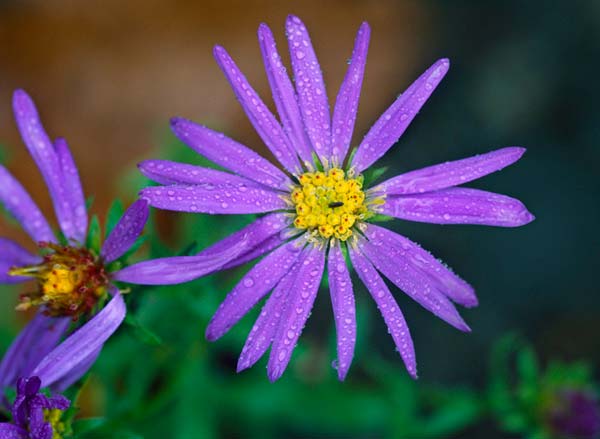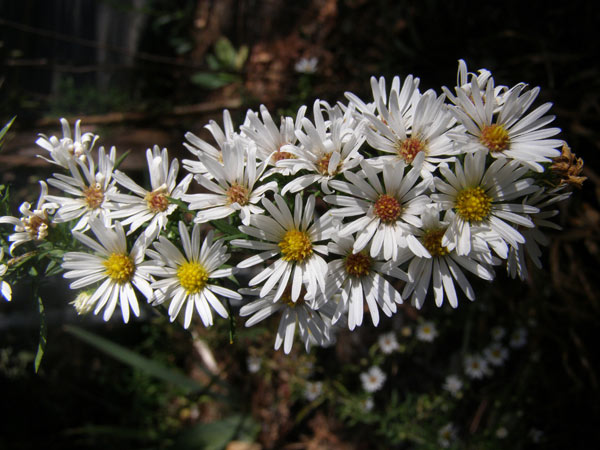Love letter to Frost Asters
By Ken Moore
Flora Columnist
Referring to my annual enthusiastic descriptions of most common flowering weeds, gardening friend Sally recently stated that she was waiting for Ken Moore’s “love letter†to the Frost Aster. Aptly named, Frost Aster, Aster pilosus (Symphyotrichum pilosum), does flower during the frosty days of mid-October.
Back in the olden days – the decades of the 1960s into the ‘90s – the mid-October week of the NC State Fair generally signaled our first hard, killing frost. In addition, at least one day of chilling rains challenged nursery staff and garden club members installing display gardens for the fair’s Flower and Garden Show. Our local Piedmont’s peak of fall color was also a treat for travelers along the roadsides from Carrboro-Chapel Hill to and from the fairgrounds. Well, not this year.
The “times are a’changing,†and now our killing frosts arrive in late November or early December.
However, Frost Asters are right on schedule along roadsides and in fields.
These white asters are real survivors, persisting vigorously on the barest and driest of soil surfaces. They even flower profusely close to the ground following persistent roadside mowing. Left to grow, a single plant can reach a height of five to six feet, taking the form of a miniature tree festooned in a canopy of tiny pure white daisies. Viewing a whole field of Frost Asters can be overwhelming, like viewing a terrace filled with fall mums. The beauty of a single plant and a single flower is missed entirely. Focus your attention on one plant; look closely at an individual flower head. No two are alike and sometimes you find ones that are shades of pink and lavender.
Noted local author and philosopher Paul Green described: “There are many species of this wild weed or flower. The pastures and wastelands and roadsides are beautiful in autumn by its profusion of white, pink, blue, lavender and purple bloomings. For all its beauty it still awaits the praise of a single Valley (the Cape Fear River Basin) poet.†Paul Green’s Plant Book.
Indeed, there are dozens and dozens of different species of wild aster throughout North Carolina. For pure beauty of a single flower head, my personal favorite is the Large Flower Aster, Aster grandiflorus, (Symphyotrichum grandiflorum).
And though local poets have not yet honored our wild asters in verse, numerous keen horticulturists have honored them by selecting forms as “named cultivars.†I noticed several such cultivars of our wild asters at Southern States garden center last week. If you want to appreciate the beauty of the wild species, there are many now in full flower at the Botanical Garden and a number of them are available on the plant sales shelves behind the Totten Center.
For pure pleasure, go outside and walk the local fields and you too can love an aster. And by all means, plant a few of these hardy, drought-tolerant perennials in your landscape.
Email Ken Moore at flora@carrborocitizen.com.
Find all of Ken Moore’s Citizen columns at The Annotated Flora
Photos by Ken Moore
Comments are closed.




I,who do not care for, nor plant white flowers in my rambling ‘flower bed’ allowed one weed to grow where it sprouted because it was such a graceful single stem whip, rising up with a lovely slight curve as each breeze caressed it. Ready to pull it up at any moment if ever it even hinted at getting weedy looking, I happened upon it one September day suddenly – in full bloom. And what a sight! A dancing whirlwind of white snowflakes suspended in midair above my favorite rosebush. Th wind tosses the slender stem; strong enough to withstand yet supple enough to create a vivid ballet, right here, unbidden, in my garden. And after some intensive searching fora name, I have fallen in love with a ‘symphony of WHITE; Symphyotrichum pilosum (hairy white oldfield aster)
My sister stumbled upon your website searching images for the name I’d found – and when I read your lovely encouragement for these wildflowers I just had to share. I’ll be following your website. Thank you.
(zone 5b in Illinois)